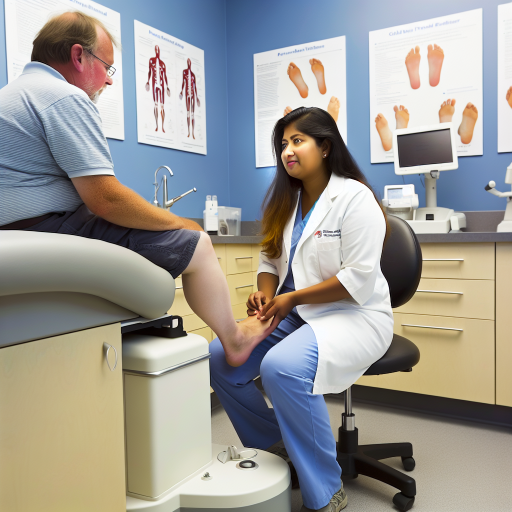Introduction to Podiatry
Role of Podiatrists in Foot Health
Podiatrists play a vital role in foot health and overall well-being.
They specialize in diagnosing and treating disorders affecting the feet and ankles.
Many individuals underestimate the importance of foot health.
However, healthy feet are crucial for mobility and quality of life.
Education and Training of Podiatrists
Podiatrists undergo extensive education and training.
They complete a Doctor of Podiatric Medicine (DPM) degree.
Additionally, they complete a residency program focusing on foot care.
This training equips them with necessary skills to treat various conditions.
Common Foot Disorders Treated by Podiatrists
Podiatrists diagnose and treat several common conditions.
- Plantar fasciitis
- Heel spurs
- Flat feet
- Diabetic foot ulcers
- Ingrown toenails
These disorders can cause pain and limit mobility.
Identifying the root cause is essential for effective treatment.
Diagnostic Techniques Used by Podiatrists
Podiatrists use various diagnostic techniques to evaluate foot health.
They conduct thorough physical examinations.
Imaging tests, such as X-rays or MRIs, help reveal underlying issues.
Furthermore, they may require lab tests to assess conditions like diabetes.
Treatment Approaches and Solutions
Podiatrists employ a range of treatment options.
Conservative treatments include physical therapy and orthotics.
In some cases, they may recommend medication to alleviate pain.
Surgical interventions may be necessary for severe conditions.
Post-operative care is crucial for full recovery.
Preventive Care and Education
Podiatrists emphasize the importance of preventive care.
They educate patients about proper foot hygiene and care.
Regular check-ups can help detect issues early.
Additionally, they advise on appropriate footwear choices.
Common Foot Disorders
Overview of Conditions Treated by Podiatrists
Podiatrists evaluate and treat various foot disorders.
Unlock Your Career Potential
Visualize a clear path to success with our tailored Career Consulting service. Personalized insights in just 1-3 days.
Get StartedMany patients suffer from conditions that affect their daily lives.
Understanding these disorders can help improve foot health.
Plantar Fasciitis
Plantar fasciitis is a common cause of heel pain.
This condition occurs when the plantar fascia becomes inflamed.
Podiatrists often recommend stretching exercises for relief.
Orthotics can also provide support and alleviate discomfort.
Ingrown Toenails
Ingrown toenails occur when the edge of a nail grows into the skin.
This can lead to pain and infection.
Podiatrists treat this condition by removing the ingrown portion.
They may also advise on proper nail cutting techniques.
Achilles Tendinitis
Achilles tendinitis causes pain along the back of the leg.
This condition affects the tendon that connects the calf muscle to the heel.
Podiatrists often recommend rest and physical therapy.
In some cases, custom orthotics may be necessary for support.
Bunions
Bunions are painful bony bumps that develop at the base of the big toe.
This condition can cause significant discomfort and misalignment.
Podiatrists often suggest wearing wide shoes to minimize pressure.
In severe cases, surgical options are available to correct the deformity.
Neuromas
Neuromas are benign growths that develop on foot nerves.
They typically form between the toes, causing pain and discomfort.
Podiatrists may recommend padding or custom orthotics for relief.
Surgical removal is considered if conservative treatments fail.
Flat Feet
Flat feet occur when the arches of the feet collapse.
This condition can lead to overpronation and discomfort.
Podiatrists often prescribe orthotics to support the arches.
Exercises to strengthen the foot muscles can also be beneficial.
Diabetic Foot Care
Individuals with diabetes are prone to foot complications.
Podiatrists play a crucial role in preventing and treating these issues.
Regular foot examinations are essential for managing diabetic foot health.
Proper footwear and daily foot care are also important recommendations.
Diagnosis Techniques: How Podiatrists Evaluate Foot Disorders
Patient History
Podiatrists begin by taking a thorough patient history.
This includes understanding symptoms and their duration.
They inquire about any previous foot issues or surgeries.
Furthermore, they ask about relevant medical history.
Patient lifestyle and activity levels also come into play.
Physical Examination
A comprehensive physical examination follows the history assessment.
Podiatrists observe the foot’s structure and alignment.
They check for swelling, redness, or abnormalities.
Palpation helps in identifying areas of tenderness or pain.
Range of motion tests assess joint flexibility.
Diagnostic Imaging
Diagnostic imaging plays a crucial role in diagnosis.
X-rays provide insights into bone structure and alignment.
They can identify fractures, arthritis, and other issues.
Ultrasound assists in evaluating soft tissue conditions.
In some cases, MRI scans are necessary for a detailed view.
Laboratory Tests
Laboratory tests help in diagnosing underlying conditions.
Blood tests can detect infections or systemic diseases.
Cultures may be taken for skin infections or wounds.
These tests guide podiatrists in planning effective treatments.
Functional Assessments
Functional assessments evaluate the foot’s performance during movement.
Podiatrists may observe how a patient walks or runs.
Gait analysis provides insights into biomechanics and abnormalities.
This information is crucial for tailoring treatment plans.
Final Evaluation
After thorough evaluation, podiatrists compile the findings.
They then create a comprehensive diagnosis.
Next, they discuss the diagnosis with the patient.
Clear communication ensures patients understand their conditions.
The podiatrist will then formulate a treatment strategy.
Discover More: Common Questions To Ask Your Audiologist
Patient Consultation
Importance of Medical History
The podiatrist begins the consultation with a review of the patient’s medical history.
This history includes previous foot injuries, surgeries, and underlying health conditions.
For example, diabetes and arthritis can significantly impact foot health.
Moreover, understanding medication usage is crucial for assessing potential side effects.
The podiatrist asks specific questions to gather detailed information.
This process helps to identify potential risk factors for foot disorders.
Evaluating Symptoms
Next, the podiatrist evaluates the patient’s reported symptoms.
Common symptoms include pain, swelling, and changes in skin appearance.
The podiatrist encourages patients to describe pain characteristics.
Is the pain sharp, dull, or throbbing? When does it occur?
This information helps to pinpoint the underlying issue.
Physical Examination Techniques
A thorough physical examination follows the medical history and symptoms evaluation.
The podiatrist inspects the feet visually for abnormalities.
They assess foot structure, skin integrity, and nails.
Palpation helps to identify areas of tenderness or swelling.
Mobility tests assess the joints’ range of motion.
These steps provide further insights into the patient’s foot condition.
Diagnostic Tools
Podiatrists sometimes use diagnostic imaging to enhance their assessment.
X-rays help visualize bone abnormalities or fractures.
Ultrasounds may assist in examining soft tissue injuries.
Magnetic resonance imaging (MRI) is used for detailed images of complex structures.
These tools provide a comprehensive view of the patient’s foot health.
Discover More: Common Misconceptions About the Dental Profession
Physical Examination: Step-by-Step Assessment of the Foot
Initial Consultation
The first step occurs during the initial consultation.
Marcus Thompson, an experienced podiatrist, introduces himself warmly.
He encourages patients to share their concerns openly.
Gathering detailed information is crucial for diagnosis.
Podiatrists also inquire about the patient’s medical history.
This includes previous foot issues, surgeries, and relevant health conditions.
Visual Inspection
Following the consultation, visual inspection begins.
Podiatrists carefully examine both feet for abnormalities.
Common problems include swelling, discoloration, and deformities.
They assess skin condition, noting signs of fungal infections or rashes.
Nail health is also evaluated, as this can indicate larger issues.
Palpation of the Foot
Palpation is an essential component of the assessment.
Podiatrists use their hands to feel for abnormalities and tenderness.
This helps assess the ligaments, tendons, and bones beneath the skin.
By using moderate pressure, they identify points of pain.
Checking for warmth or swelling is also crucial during palpation.
Range of Motion Testing
Next, range of motion testing takes place.
Podiatrists ask patients to perform specific movements.
This assesses flexibility and joint function in each area of the foot.
They observe how easily patients can move their toes and ankles.
Any limitations may point to underlying issues requiring treatment.
Neurological Assessment
A neurological assessment follows to evaluate nerve function.
Podiatrists may use tuning forks or monofilaments for this purpose.
Patients test their sensitivity to touch or vibrations.
These tests help identify nerve damage or neuropathy.
Diagnostic Imaging
When necessary, diagnostic imaging supplements the examination.
X-rays can reveal fractures, misalignments, and bone spurs.
MRIs or ultrasounds may be used for soft tissue evaluation.
These tools aid in creating a comprehensive treatment plan.
Creating a Treatment Plan
After completing the assessment, podiatrists develop a treatment plan.
This plan is tailored to each patient’s unique needs.
Options may include physical therapy, custom orthotics, or medications.
In some cases, surgery may be warranted for severe conditions.
Communication is vital to ensure patients understand their options.
By collaborating closely, patients feel empowered in their care.
Delve into the Subject: How Kinesiology Supports Mental and Physical Wellness

Advanced Diagnostic Tools
Imaging Techniques
Podiatrists utilize various imaging techniques to diagnose foot disorders effectively.
X-rays are one of the most common imaging tools used.
These help identify fractures, bone deformities, and joint changes.
Additionally, MRI scans provide detailed images of soft tissues.
This can reveal issues with ligaments, tendons, and cartilage.
CT scans offer another valuable imaging option, especially for complex cases.
These scans can deliver precise cross-sectional pictures of the foot.
Ultrasound is also gaining popularity, particularly for soft tissue evaluations.
Laboratory Tests
Alongside imaging, laboratory tests play a crucial role in diagnosis.
Podiatrists often order blood tests to check for underlying conditions.
These may reveal diabetes, rheumatoid arthritis, or infections.
Urinalysis can also provide important information regarding kidney function.
In some cases, podiatrists may perform cultures to identify specific pathogens.
This is especially relevant for chronic wounds or severe infections.
Clinical Assessments
Clinical assessments complement diagnostic imaging and laboratory tests.
Podiatrists perform thorough physical examinations of the foot.
During these assessments, they check for swelling, pain, and range of motion.
They also evaluate foot posture and examine gait mechanics.
Furthermore, patient history is critical in understanding symptoms.
Health professionals gather information about past injuries or surgeries.
This comprehensive approach supports accurate diagnoses and treatment plans.
Learn More: The Growing Demand for Dentists Across Canada
Treatment Options: Non-Surgical vs. Surgical Approaches to Foot Disorders
Non-Surgical Treatment Options
Podiatrists often start with non-surgical treatments for foot disorders.
This approach is less invasive and allows for quicker recovery.
Common non-surgical options include orthotics, physical therapy, and medications.
Orthotics are custom-made inserts that improve foot alignment.
Physical therapy can strengthen foot muscles and improve mobility.
Medications help reduce pain and inflammation.
In some cases, corticosteroid injections provide temporary relief.
Moreover, lifestyle modifications can significantly enhance treatment effects.
Patients may need to adjust their footwear or weight for better outcomes.
Regular follow-ups ensure that progress is monitored and adjustments made.
Surgical Treatment Options
If non-surgical methods fail, podiatrists may recommend surgical interventions.
Surgery aims to correct structural issues within the foot.
Common procedures include bunionectomy and tendon repair.
A bunionectomy removes the bony bump at the toe joint.
Tendon repair restores function and alleviates pain in severe cases.
Other options may involve fusions or realignment of bones.
Post-operative care is critical for a successful recovery.
Rehabilitation may include physical therapy to regain strength and function.
Patients should follow their surgeon’s guidelines for optimal results.
Choosing the Right Approach
Deciding between non-surgical and surgical treatments requires careful consideration.
Patients should discuss their specific conditions thoroughly with their podiatrist.
Factors include the severity of the disorder and overall health.
A collaborative approach ensures that treatment aligns with patient needs.
Podiatrists aim for the most effective and least invasive solutions.
Ultimately, the goal is to restore foot function and alleviate pain.
Rehabilitation and Aftercare: Essential Follow-Up Practices for Recovery
Importance of Rehabilitation
Rehabilitation plays a crucial role in recovery.
It helps restore function and mobility in the feet.
Moreover, proper rehabilitation minimizes the risk of future injuries.
Individualized Rehabilitation Plans
Podiatrists create customized rehabilitation plans for each patient.
These plans consider the specific foot disorders and patient abilities.
Patients should follow their plan closely for effective recovery.
Strengthening Exercises
Strengthening exercises enhance muscle strength in the feet.
Exercises may include toe curls and heel raises.
Performing these exercises regularly aids in rehabilitation.
Flexibility and Stretching
Flexibility exercises improve the range of motion in the feet.
Stretching can alleviate tightness and promote healing.
Incorporate stretches like calf stretches into your routine.
Importance of Follow-Up Appointments
Regular follow-up appointments are essential.
Podiatrists can monitor progress and address concerns.
They may make necessary adjustments to the rehabilitation plan.
Evaluating Recovery Progress
During follow-up visits, podiatrists evaluate recovery progress.
They assess strength, flexibility, and pain levels.
This evaluation helps ensure patients are on the right track.
Patient Education
Patient education is vital during follow-up care.
Podiatrists provide information on proper foot care practices.
Understanding how to care for your feet promotes long-term health.
Post-Rehabilitation Care
After completing rehabilitation, ongoing care remains critical.
Patients should continue to practice foot care techniques.
This may include wearing proper footwear and maintaining a healthy weight.
Monitoring for Recurrence
Patients should watch for signs of recurrence after treatment.
Early detection of issues allows for timely intervention.
Stay in communication with your podiatrist regarding any concerns.
Maintaining an Active Lifestyle
Staying active helps maintain foot health post-rehabilitation.
Engaging in low-impact activities, like swimming or cycling, is beneficial.
These activities provide cardiovascular benefits without stressing the feet.
Additional Resources
NOC 2011 – 312 – Optometrists, chiropractors and other health …
Peripheral artery disease (PAD) – Diagnosis and treatment – Mayo …




